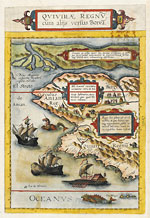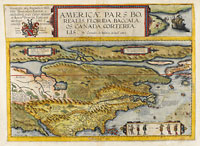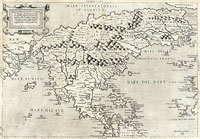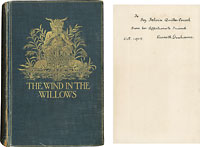Autographs and Photographs: From Button Gwinnett and J. D. Salinger to street photographer Robert Frank
Italian and Dutch Attempts at Mapping North America
Paolo Forlani, Il Disegno del discoperto della nova Franza … £121,250 ($182,700) and Cornelis de Jode, Americae pars Borealis … with Quivirae Regnu[m] …, £36,250 ($54,620) the pair, at Sotheby’s London on May 6
So-called Lafreri School maps represent a remarkable flowering of Roman and Venetian mapmaking of the period 1540-70. They get their name from someone who was in fact better known as a mapseller than as a publisher, but it is Giacomo Gastaldi, whose work was copied and adapted by many others, and Paolo Forlani, the most active of these engraver-publishers, who are the key names.


Examples of such maps were among highlights of a sale of the cartographic collection of Italian-born U.S. collector, Frank Benevento—among them the famous Forlani North America map of c.1565, the earliest separately published map of the region. Benevento’s copy was a first state issue, without an imprint in the title cartouche—something virtually unknown on the open market–and a fine, dark impression, although trimmed to the engraved area and inlaid for inclusion in an atlas of the period.
Described by Sotheby’s as the next improvement on the Forlani map was the first Dutch map of North America, a two-part map prepared for the 1593 second edition of the de Jode Speculum Orbis Terrarum, though the mapmaker’s attempt to reconcile conflicting reports from English and French sources resulted in some odd alignments on the eastern seaboard.
The de Jode atlas was a superior production to the much more famous Ortelius Theatrum, but its publication was frustratingly delayed—probably engineered by Ortelius’ influential contacts—and the Theatrum was launched first and sold more copies. As a result the de Jode atlases and individual map sheets such as these are now scarce.
The two maps that make up de Jode’s North America, though contiguous, were printed separately in the atlas and sold separately at Sotheby’s for £27,500 ($41,435) and £8,750 ($13,185) for the smaller Alaska and Northwest portion of the map. Both maps went to dealer Graham Arader, who bought heavily at the Benevento sale.
Was Foy’s Dad the Model for Ratty?
Kenneth Grahame, The Wind in the Willows, £32,400 ($48,795) at Bonhams London on March 23
Five-figure sums for copies of this children’s classic are generally reserved for examples in the rarely seen dust jacket. The record bid of £43,700 (then $72,690) seen at Sotheby’s in 1998 has not so far been beaten, but just last December, another made £30,000 ($48,880) in the same saleroom.
This 1908 first had no jacket. Methuen’s gilt-decorated cloth binding with its design of Mole and Ratty, asleep in their boat beneath the awesome figure Pan on the upper cover, was rubbed and splitting at the upper joint. But on the front free endpaper, this very special copy was inscribed “To Foy Felicia Quiller Couch from her affectionate friend Kenneth Grahame, Oct. 1908.”
Foy was the daughter of the Cornish writer and anthologist, Sir Arthur Quiller-Couch, whose house in the lovely Cornish harbor town of Fowey (pronounced Foy) was visited frequently by Kenneth Grahame. It was while staying there that Grahame began work on The Wind in the Willows and his host, Quiller-Couch, who was fond of messing about in boats, is thought to have been the model for Ratty. Quaritch of London purchased this very desirable copy.








 Ian McKay’s weekly column in Antiques Trade Gazette has been running for more than 30 years.
Ian McKay’s weekly column in Antiques Trade Gazette has been running for more than 30 years.
